|

Report on the CodePink delegation to Pakistan
by Joe Lombardo, UNAC co-coordinator
I arrived in
Islamabad at 2:30 am on October 3 with about 7
other members of our delegation after a grueling flight from New York.
We were part of the Code Pink anti-drone delegation to Pakistan. On arrival in Islamabad, we were amazed to see a large
group of people welcoming us from the Aafia Siddiqui movement. This is a movement in support of Aafia
Siddiqui who is in solitary confinement in a Texas prison serving an 86 year
sentence. Aafia, like other Muslims in
prison in the U.S.
as part of the phony “War on Terror,” is guilty of nothing. I will explain more about her case later in
this report.
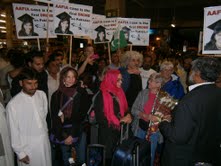
After
arriving at our guest house where the entire delegation was staying, I had
about 1/2 hours sleep before meeting the rest of the delegation at our
orientation. Others on the delegation
include Col. Ann Wright, who quit the military and her diplomatic post over the
invasion of Iraq, Medea Benjamin, the dynamic leader of Code Pink, Leah Bolger,
president of Veterans for Peace and UNAC administrative committee member, Judy
Bello of the Upstate NY Coalition to Ground the Drones and End the Wars and UNAC administrative committee
member and a host of other wonderful activists and individuals, including 3
other members of the Upstate New York Coalition. We were 31 people in all.
On our first
day in Pakistan, we met with
the acting U.S.
ambassador, Richard E. Hoagland, who made the fantastic statement that no
civilians have been killed by the drones since 2008 (the year Obama became
president). At another time he said the
civilian casualties were in the 2 figures (< 100).
We also held
a meeting with a leading human rights fighter and with Fowzia Siddiqui, Aafia Siddiqui’s sister.
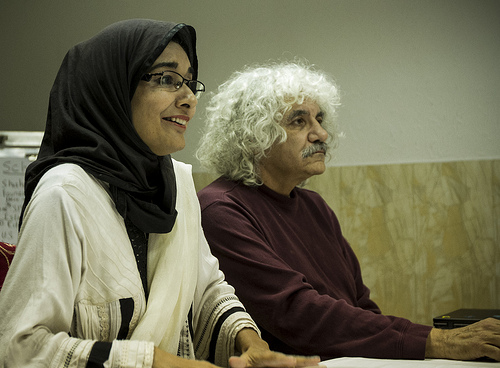
Aafia Siddiqui
is a young Pakistani woman who was educated in the U.S. She did undergraduate work at
MIT and got doctorate from Brandeis. She eventually returned to Karachi, Pakistan where her
family lives. She had 3 children, 2 born in the U.S.,
making them U.S.
citizens. In 2003, Aafia took her 3 children, ages 6 months to 6 years, on a
trip to Islamabad
and disappeared. The U.S. and
Pakistani government both denied having her in custody. Five years passed and her family feared she
and her children were dead when they got word from a reporter that she was
alive and at Bagram Air base in Afghanistan. NBC news also confirmed this and the U.S.
government finally admitted they had her in custody. She was taken to the U.S. and tried for assaulting a U.S. soldier in Ghazni, Afghanistan
while she was in custody waiting to be interrogated. During this
alleged incident, 4'11" Aafia was shoot twice. She was convicted and is
now serving 86 year in solitary confinement at the notorious Carswell
prison in
Texas. Her
family has had almost no contact with her and have been denied the right to
visit. Her son Ahmed, a U.S.
citizen, was found in 2008 in Ghazni, Afghjanistan. He was then reunited with
Aafia’s sister, who heads her defense campaign in Pakistan. Aafia’s daughter, Maryum, also a U.S. citizen, was mysteriously dropped off in
April 2010 near her aunt’s house in Karachi
after being missing for 7 years. When dropped off, the only language she knew
was English, which she spoke with a perfect American accent. Aafia’s youngest child, a boy, remains missing
and is feared dead.

At night,
some of us met with members of the newly formed Women's International League
for Peace and Freedom (WILPF) chapter of Pakistan. We had a good
discussion. One of the themes that came out and that I have heard from
others progressive people in Pakistan
was that maybe the drones are not that bad. They only hit the
"militants" who are violent themselves, and if they were not used,
the Pakistani military would have to attack the "militants" and many
more would be killed. We explained our view that the so called
"militants" were there because of the war in Afghanistan. If you want to
end the "militant" actions, you need to stop the war. This
theme of the drones not being so bad is one that we heard a number of times in Pakistan from the secular progressive movement
who is against the U.S.
wars. People we met from the left, such
as the Labour Party of Pakistan (LPP), were clear that they were totally
against the drones and the wars but they also held a position against the
“militants.” I had long discussions with
them on this. The secular left and the
conservative Islamic movement, while agreeing on the need to fight U.S.
imperialism, have been mortal enemies and, at times, have physically battled
each other. Our delegation got a hint of
this at a meeting that the LPP set up for our delegation with the Bar
Association of Islamabad, which I will report on later in this article. The people from the LPP whom I spoke with
understood why, in the U.S.,
our focus is totally on U.S.
imperialism.
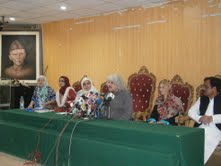 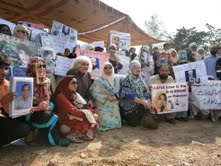
On our
second day in Pakistan,
I spent a lot of time apart from our delegation. In the morning, Judy Bello and I spoke at a
press conference with Fowzia Siddiqui and people from the Committee of the
Disappeared. As in Latin American under
various dictatorships, people in Pakistan were disappeared as
happened to Aafia Saddiqui. Judy and I spoke at the press conference
along with Aafia’s sister, the woman who heads the Committee of the Disappeared
and a couple of other people. There were a lot of media, and they asked a
lot of good questions. Outside the press conference, about 100 people, mostly
women and children who are family members of the disappeared were waiting for
us. We met with them. They wanted to be with us, many were crying.
They carried pictures of their loved ones in the hope that it would help
them find them. It was one of those situations where you just feel helpless,
and there is nothing that you can say.
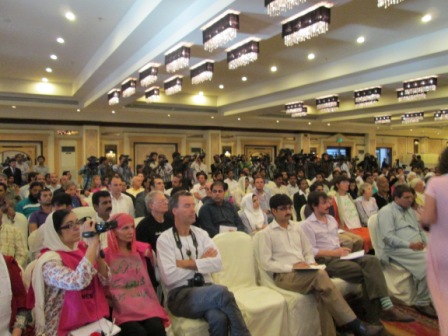 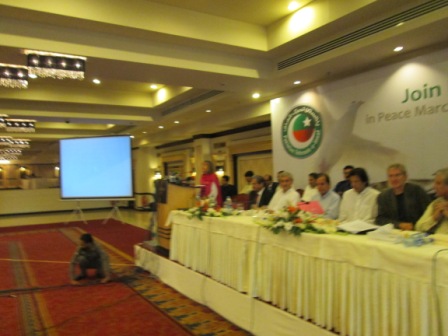
After the
press conference and our meeting with the disappeared, we met up with the rest
of our group and attended a press conference with Imran Khan. The press conference was huge and had media
from all across Pakistan,
from the U.S.
and around the world. Medea spoke for
our group. It was clear to me at this press
conference how important our tour to Pakistan was and how glad I was
that
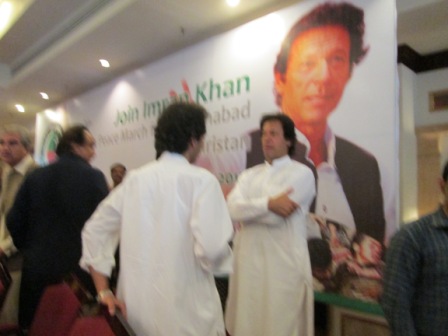
Code Pink had the ability and political clarity to organize it. Our tour raised the profile of the drone
issue in Pakistan, the U.S.
and other places. It was a big blow to U.S. war policy and put the U.S. on the defensive on this
issue. It happened at the very time that
a study from Stanford and NYU and another study from Columbia on the use of drone warfare came out
condemning drone warfare and explaining the affects on the civilian population. Since then,
there have been a number of articles in the corporate media questioning the use
of drones.
That night I
went to the home of one of the people from the Labour Party of Pakistan (LPP)
and met with about 10 people. We had a
long informal exchange of ideas. They
wanted to know everything about the antiwar movement and the left in the U.S. They told me about their merger plans with
two other secular left parties in Pakistan, the Workers Party and the
People’s Party. This merger is big news
in progressive circles in Pakistan,
and we heard about it in several places.
On April 9,
2011, when UNAC held demonstrations against the wars in New
York and San Francisco, the Labour
Party of Pakistan organized solidarity actions in several cities in Pakistan
After our
discussion, I was taken to the office of the Tribune newspaper, where I met the
staff and editors and had a long interview.
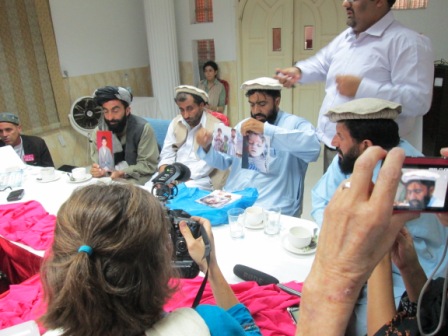
On our third
day in Pakistan,
we met with a number of men who had had family members killed in drone
attacks. They all were from North Waziristan.
Before they came, our hosts told us that they may be uncomfortable in a
room with both men and women and may not make eye contact with the women out of
respect. Most of the talking was done by
one man who lost his son and a brother in a drone attack. He was a Malik, a tribal leader. (On the way back from Waziristan
I was able to spend over an hour talking to this man one-on-one.)
According to
the introduction to the Federal Administrated Tribal Areas (FATA) given by our
hosts, these are areas that are part of Pakistan but are autonomous. They have their own governing bodies. The highest governing entity is the jirga,
which is a meeting of tribal officials.
The main language in Pakistan
is Urdu, but in this area the main language is Pashto. The FATA areas of North and South Waziristan
are where the drone strikes have taken place, two-thirds of them in North Waziristan.
We learned
that drones fly overhead 24 hours a day.
People are afraid to congregate, fearing they we be seen as a gathering
of “militants” and will be attacked.
Children no longer go to school because of fear that they will be
attacked. This has caused a lot of
psychological disorders in this area, and for the first time in their
communities they are seeing instances of suicide. At one point, the regional jirga was targeted
and 54 people were killed. Typically,
the U.S. and Pakistan don’t
give compensation when someone is killed by the drones, but in this case they
offered $6,000 for each family. This is
a lot of money for these people, but it was refused by everyone. They said they want justice, not money.
Also at the
meeting was a journalist from North Waziristan
who has been documenting the drone strikes.
When there is a strike, he gets notified and goes to the site and
records who is killed and takes pictures.
Some of these pictures were blown up and put on our busses as we rode
towards Waziristan the following day. Because of their customs, he is unable to
take pictures of women or even record their names, but he has recorded the time
and place where 670 women have been killed by the drones. This is far different than what we heard from
the ambassador. I tend to believe the
journalist from North Waziristan rather than our government who lied to us
about weapons of mass destruction in Iraq.
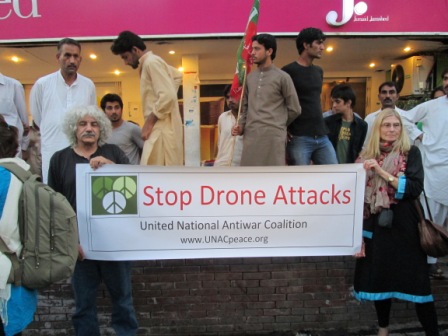 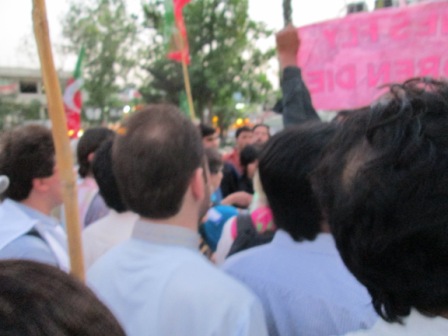
After this
meeting, we went with these men from North Waziristan
to a rally against drones organized at a close-by shopping area by the youth
group of Imran Khan’s Justice Party.
We then went
back to our hotel to get ready for our journey north to Waziristan
the following morning. Before leaving
for Waziristan, the U.S.
government made one last attempt to stop us.
The ambassador called and told us that they had received “creditable
reports” that if we were to go to Waziristan,
we would be attacked. To me, this
indicated the power of our march to Waziristan. All three tribal leaders in South
Waziristan wanted us to come.
They said we were their guests and would be protected. This march included Americans and Pakistanis
and was supported by those in the tribal areas.
It indicated that we all want peace, so it raised the question, why do
we have war?
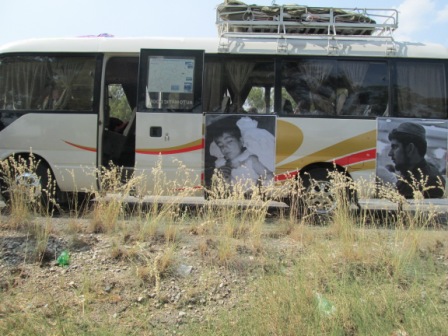
On Saturday
morning we boarded our busses to meet up with Imran Khan’s convoy to head to South Waziristan. Almost immediately, everything
fell apart. We were supposed to by right
behind Imran Khan, but never quite got into that position. At times on the way
north, we seemed to lose the caravan and then would meet up with it again
later. The caravan went through poorer
rural areas and beautiful landscapes. At
times when we were separated, our hosts got concerned and asked us to close the
curtains on the busses and make sure that the women had their heads
covered.
 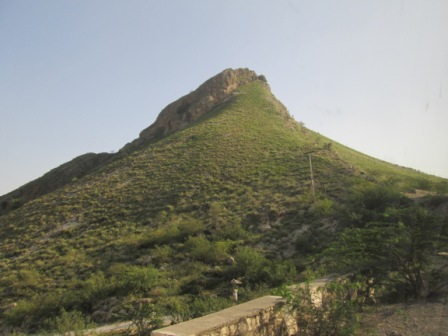
As we passed
through towns on the way north, we were met by crowds of members of Imran Khans
party. The convoy stopped at several of
these towns and held anti-drone rallies.
Because we were not up front near Imran Khan in the convoy, we did not
hear or participate in these rallies, but the crowds remained, knowing that our
busses would pass by them. When we did
pass them, they cheered and flashed peace signs.
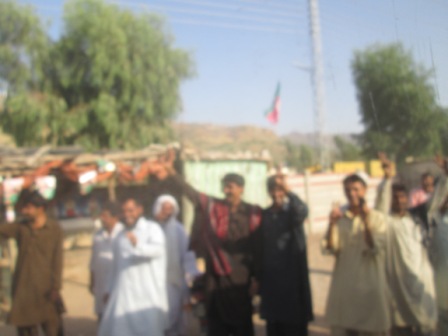 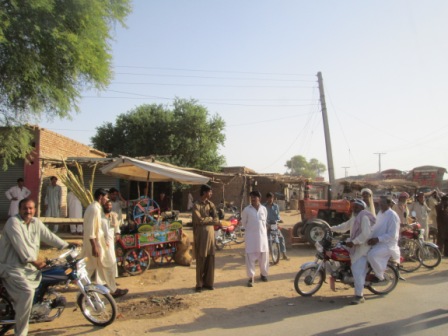 We reached
our destination for the night very late, around midnight. We stayed in the compound of a big farm about
10 km (around 6 miles) from the border with Waziristan. Outside and inside the compound were crowds
of people spending the night, getting ready for the trip across the border. As we walked from our busses into the
compound, we were treated like heroes.
People shouted welcome and peace.
Everyone wanted to take a picture with us. We were fed a meal at midnight and held a
meeting. Some were concerned that the
security that we were supposed to have on our ride to the border never materialized and
wanted to make sure that it was rectified in the morning.

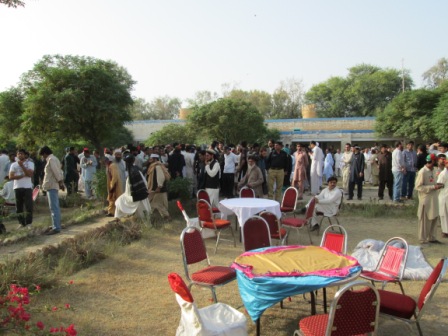
That night
we learned that the military had blocked the roads into Waziristan
with big storage containers and would not let us cross the border. They said that this was for our own
safety. Imran Khan was determined to
make an effort to cross the border despite the containers. In the morning he met with our group and
leaders of his party, and our hosts encouraged us not to go with him the extra
6 miles to the border. If we were
stopped by the containers, they understood that it would be difficult to turn
all the cars in the large caravan around, and there would be a massive traffic
jam.
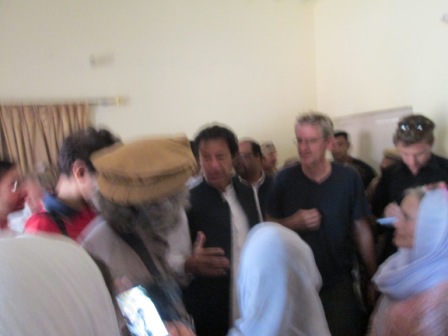
In this situation our safety might
be of concern. Instead, before leaving
they organized a big rally at the compound where Imran and Medea spoke to
cheering crowds shouting “Welcome,” “Peace,” and “Stop, stop, stop drones
attacks.” This rally was held on October
7, the 11th anniversary of the invasion of Afghanistan as
demonstrations were taking place in the U. S. and other parts of the world.
It was
understood that the political power of this trip with our delegation had
already been achieved, and therefore, the risk was not worth it at this
point. So after the caravan cleared out
of the compound heading north, we left and headed south accompanied by a police
escort all the way back to Islamabad.
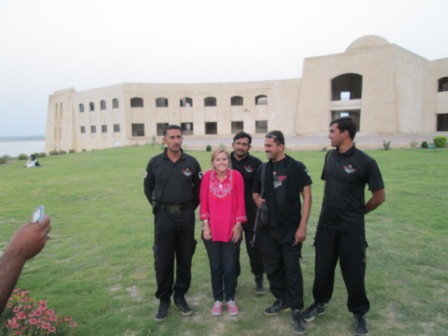
On the way
back to Islamabad,
we stopped at a rural college that was built by Imran Khan. This was a college of engineering and
computer science he established primarily for those who might otherwise not
have access to higher education. Ninety
percent of those attending are there on scholarship. It was meant to be the first of many schools
accessible to everyone within a “city of knowledge” envisioned by Imran
Khan. We also were told about a cancer
hospital he’d built at which anyone could obtain treatment, whether they could
afford it or not.
After
returning to Islamabad,
we rested. The next day, Monday, was a slow one. We did have a follow-up meeting with the
Ambassador. Only six of us, including
me, attended this meeting. We asked him
to hear the evidence we had of Pakistani civilian deaths from U.S. drone
attacks. He said he would. Some people in our group felt the Ambassador
opened up to us more on this occasion than is usual. At times, he asked us to turn off the
recording devices so he could say something off the record. However, he stuck to the line that there were
almost no civilian deaths and that if there were, they were anomalies. I did not have much hope that our talk with
the Ambassador would advance our cause at all.
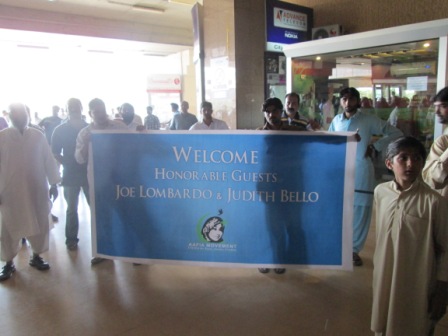 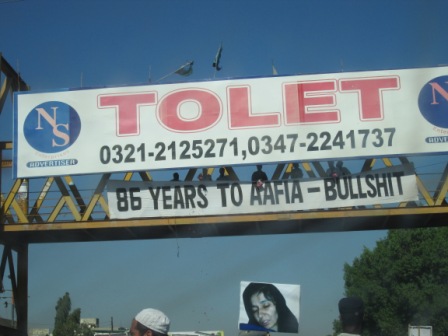
On Tuesday
and Wednesday, Judy Bello and I separated from the group to spend a day in Karachi with the Aafia folks and another in Lahore with the LPP
folks. When we got off of the plane in Karachi, we were met by a
group of people holding a big banner stating, “Welcome to our honored
guests, Joe Lombardo and Judy Bello.” We
were taken by car to Aafia’s home to meet her mother and children. All along the road, we saw banners and wall writing
in honor of Aafia Siddiqui. My favorite
sign said, “86 years to Aafia – bullshit.” At one
point, there was a truck in the middle of the road surrounded by people and
cars. The truck had speakers on it that
were playing a song sung in Urdu. It was
a popular folk song written about Aafia.
Our car fell in behind the sound truck and started a caravan to Aafia’s
house. As we got closer, the road
became packed with people welcoming us, waving, chanting, giving peace signs,
and throwing flowers. The major road we
were on was taken over by this crowd, and our car went along with them at a
slow pace. At one point I got out and
walked with the crowd. The police
escorted us and smiled and waved at us.
As we got closer to Aafia’s home, we saw that her entire street had been plastered
with huge pictures of demonstrations held across Pakistan and in other countries
demanding her release. There was one
picture of a demonstration in Pakistan
that we were told was attended by over a million people.
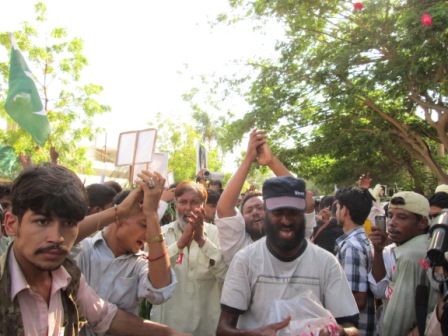 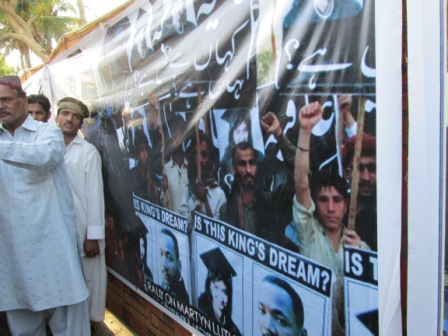 We held a
well-attended press conference at Aafia’s house and met her mother and her son
and daughter. As always, they fed us
till we could not look at food anymore. After
meeting the family, we were taken to the University of Karachi,
where Judy and I spoke to a lecture hall full of students and answered
questions. It was a very good exchange,
and they were friendly and happy to see us, but the questions brought home once
again how much people hate the U.S.
government and don’t understand why it does such terrible things.
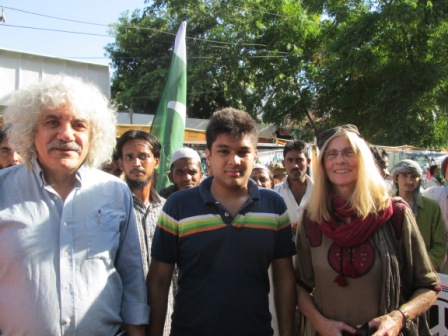
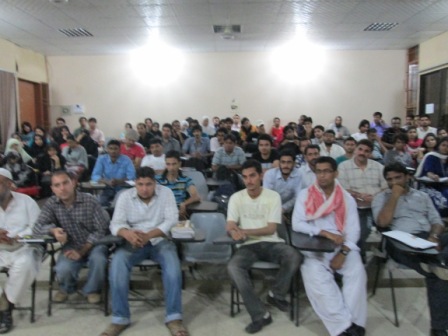
After the
University meeting, we were taken to meet the Pakistani 1%. We were brought to an exclusive club on the
ocean and sat at a table with the big owners of the textile mills and other
industries in the industrial city of Karachi. Aafia’s sister, Fowzia, explained that they
hoped to get money from these people for their campaign. These people knew about our delegation and
the trip to Waziristan with Imran Khan. They were very interested in what we had to
say, and they too expressed confusion and anger towards the policies of the U.S.
government.
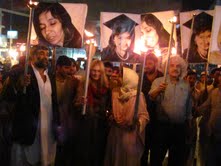
On the way
back from this meeting, we were taken to a commercial area near the docks. There we found the sound truck again playing
Aafia’s song and a crowd of young men demonstrating for her freedom. Once again, we were greeted like heroes. We all got out of the car and marched with
the protesters. We carried lit torches
through the streets.
On the last
day of our trip, October 10th, we flew to the city of Lahore,
near the border with India. Members of the LPP met us and took us to a
hotel, where we rested for a few minutes before we were picked up by Farooq
Tariq, one of the LPP leaders.
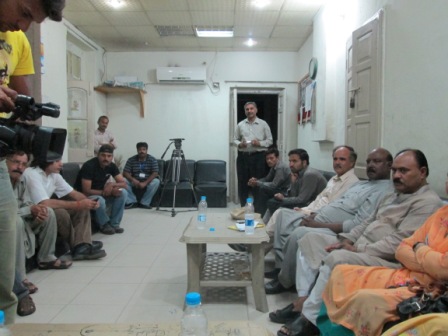
We were
taken to the Lahore
headquarters of the LPP, where we had an informal discussion with a group of
members, and then went to a meeting with the Punjab Union of Journalists. We were also interviewed by some journalists
from U.S.
media. But the meeting had to be cut
short because, as the world knows, on this last day of our trip, which had
gotten daily headlines in the Pakistani media, a 14 year old girl, Malala
Yousufzai, was shot by the Taliban.
Demonstrations against the shooting were quickly organized. Judy and I attended two of them organized by
the LPP and other groups in Lahore. At the same time, the rest of our group
attended a similar demonstration back in Islamabad.
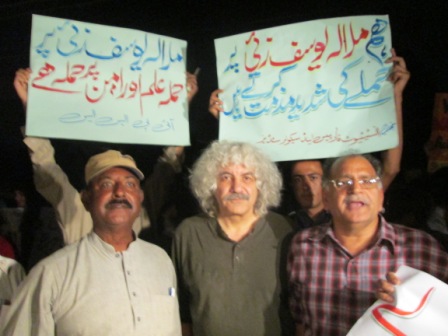 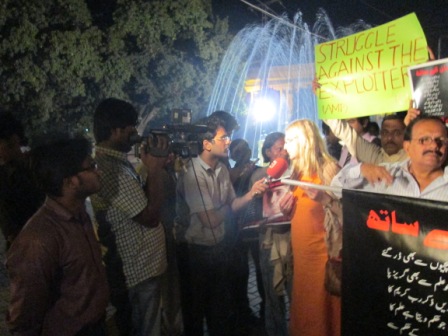
One other
incident occurred with our group back in Islamabad
while Judy and I were in Lahore. Lawyers who are members of the LPP organized
a meeting for the group at the Bar Association in Islamabad.
There had been some tension among members of the Bar Association, some
of it centered around a case that some of the lawyers were defending. A while ago, the governor of Punjab province
came out publically for getting rid of Pakistan’s blasphemy laws. After this, he was shot and killed by a
police officer. The police officer was
caught and is now on trial. Some of the
conservative lawyers supported the action of the police officer and are
defending him. These lawyers decided
that Americans should not come to the Bar Association and tried to block the
group. There was a verbal confrontation
but they backed down and the meeting went on over their objection.
While we
were on our way to Waziristan on October 6th and 7the, there was a meeting held
in Lahore with 100 representatives of
progressive secular groups from Pakistan
and Afghanistan. There were around 80 people from Pakistan and 20 from Afghanistan at this meeting. The people from the LPP saw this as a very
important meeting, as did I. They told
me that they want to work closely with the U.S. antiwar movement.
The trip to Pakistan was very important, in my opinion, in
building the U.S.
and Pakistani movement against the drones and the wars. It showed people in Pakistan that
not all Americans are bad. We got
tremendous publicity throughout Pakistan
and were even able to break into the U.S. corporate media as well as
media around the world. Drones are now
on people’s radar (no pun intended) as never before inside the U.S. and Pakistan. Our 31 activists can now bring this message
of peace and no-drones back to our communities and build a stronger
movement. Code
Pink is to be applauded
for organizing this trip, and we all need to read Madea Benjamin’s
book, Drone Warfare, Killing by Remote Control, to further arm
ourselves for the struggle ahead.
click
here to donate to UNAC
Click here for the Facebook UNAC group.
To
remove yourself from the UNAC listserv, please send an email to:
UNAC-unsubscribe@lists.riseup.net
To add yourself to the UNAC listserv,
please send an email to: UNAC-subscribe@lists.riseup.net |
|












